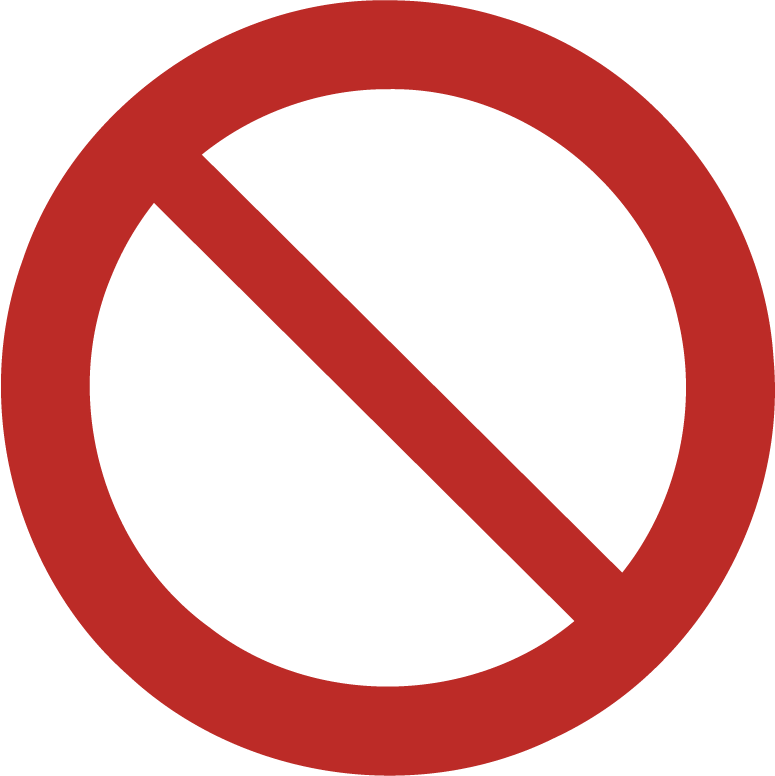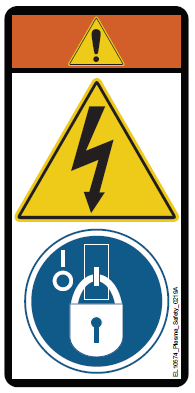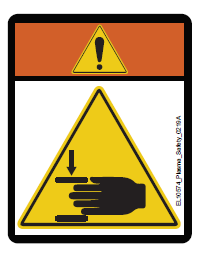In This Section, You'll Learn:
About the standards and safety precautions associated with this machine.
Before operating the machine in any way, you must read and understand this section.
Safe operation of the machine depends on its proper use and the precautions you take. Only trained personnel — with a clear and thorough understanding of its operation and safety requirements — shall operate this machine.
Intended Use
This machine is intended for general-purpose, computer numerical control (CNC) machining in the following applications:
-
Educational environments
-
Hobby applications
-
Light production
-
Prototyping
-
Research and development
-
Secondary operations
The intended use includes:
-
Appropriate workholding, toolholding, tooling, systems, and machining parameters.
-
Plasma cutting and engraving of ferrous and non-ferrous metals.
The intended use does not include machining materials that:
-
Are abrasive, carcinogenic, explosive, flammable, radioactive, or toxic
-
Produce aerosols or fine particulates when machined
The intended use does not include the following materials (not a full list):
-
Beryllium and its alloys
-
Ceramics
-
Fiberglass
-
G10 fiberglass laminate
-
Graphite
-
Magnesium and its alloys
To safely operate products, you must obey all safety precautions and warnings that are on the machines and in the documentation.
Machine Standards
When installed and operated as intended (see "Intended Use"), this machine complies with the following standards. You must follow the requirements listed in the standards so that the machine remains compliant.
American National Safety Institute (ANSI)
-
ANSI B11.TR3-2000 Risk Assessment and Risk Reduction — A Guideline to Estimate, Evaluate, and Reduce Risks Associated with Machine Tools
-
ANSI Z49.1:2005 Safety in Welding, Cutting, and Allied Processes
Occupational Safety and Health Administration (OSHA)
-
OSHA 1910.212 General Requirements for All Machines
Safety Overview
Any machine tool is potentially dangerous. A CNC machine's automation presents added risk not present in a manual machine.
Before operating the machine in any way, you must read and understand this section.
-
Read and understand all safety messages used in this document.
-
Locate and understand all safety decals on the machine.
-
Locate and become familiar with all information decals on the machine.
Safety Messages
The following examples show the standard safety message types used to draw your attention to important information. The standards distinguish between personal injury safety messages and property damage warning messages.
Personal Injury
Personal injury safety messages have safety alert symbols and the following hazard level labels:
DANGER! Indicates a hazard with a high level of risk which, if not avoided, will result in death or serious injury.
WARNING! Indicates a hazard with a medium level of risk which, if not avoided, can result in death or serious injury.
CAUTION! Indicates a hazard with a low level of risk which, if not avoided, can result in minor or moderate injury.
Property Damage
NOTICE! Indicates a hazard which, if not avoided, can cause property damage.
Safety Decals
Before operating the machine in any way, you must read and understand all installed safety decals on the machine and equipment. Do not remove any safety decals. If any safety decals become worn or damaged, contact Tormach Technical Support for guidance on receiving replacement decals.
The following types of safety symbols are on the decals:
-
Warning

This symbol indicates a hazard which, if not avoided, can result in personal injury or property damage.
-
Prohibition

This symbol indicates an action that shall not be taken or that shall be stopped.
-
Mandatory Action

This symbol indicates an action that you must take to avoid a hazard.
On the Electrical Cabinet Door

-
WARNING! Electrocution Hazard. Points in the electrical cabinet contain high voltages, which can electrocute or shock you, causing death or serious injury. Even after the machine is powered off, electronic devices in the electrical cabinet can retain dangerous electrical voltages. Use caution when servicing the machine inside the electrical cabinet.
-
Lockout/Tagout. Before servicing the machine, you must power off the machine and use an approved lockout/tagout device to secure the Main Disconnect switch in the OFF position. Points in the electrical cabinet contain high voltages, which can electrocute or shock you, causing death or serious injury.
On the Front of the Bed

-
WARNING! Arc Flash Hazard. The plasma arc process produces very bright ultraviolet and infrared rays, which can injure your eyes and burn your skin. Always wear appropriate personal protective equipment to avoid damage to your eyes and skin.
-
Don't Operate with an Active Implanted Cardiac Device. If you wear an implanted cardiac device, you must consult with your doctor before operating this machine. The machine-generated electromagnetic fields could either interfere with or damage an implanted cardiac device.
-
WARNING! Fire Hazard. The machine is not designed to contain fire or explosions. Only use materials and coolants that are intended for the specific machining operation. Never use flammable or explosive items. Before operating the machine in any way, you must read all Safety Data Sheets (SDSs) for any workpiece materials, coatings, coolants, lubricants, and other consumables used.
-
WARNING! Inhalation Hazard. The machine does not protect you from airborne particulates. Chips, dust, and vapors from certain materials can be toxic or otherwise harmful. Before operating the machine in any way, you must read all Safety Data Sheets (SDSs) for any workpiece materials, coatings, coolants, lubricants, and other consumables used.
-
Personal Protective Equipment: Eyes. Prevent injury by always wearing protective safety eyewear. Before operating this machine in any way, you must verify that your eyewear is impact-resistant and rated for ANSI 787+.
-
Operator Knowledge. Before operating this machine in any way, you and all other operators must read and understand all instructions. If you don't, there's a risk of voided warranty, property damage, serious injury, or death.
On the Gantry and the Plasma Head

-
WARNING! Crush Hazard. Moving parts can entangle, pinch, or cut you, causing death or serious injury. Before operating this machine in any way, you must verify that all body parts, long hair, and clothes are clear of the machine's extent of motion.
Information Decals
Before operating the machine in any way, you must locate and become familiar with all installed information decals on the machine and equipment.
Serial Number Plate
The serial number plate is on the side of the electrical cabinet, near the Main Disconnect switch.

Machine Safety
Before operating the machine in any way, you must read and understand this section.
Safe operation of the machine depends on its proper use and the precautions you take. Only trained personnel — with a clear and thorough understanding of its operation and safety requirements — shall operate this machine.
General Shop Safety
-
Verify that only qualified machinery maintenance professionals install, set up, or perform maintenance on this machine.
-
Keep the work area well-lit. Use additional lighting if needed. The work area should be illuminated to a minimum of 500 lx.
-
Keep the work area temperature- and humidity-controlled.
-
Remove loose-fitting clothing, neckties, gloves, and jewelry.
-
Tie up long hair and secure it under a hat.
-
Wear safety eye protection rated for ANSI Z87+.
-
Wear safety eye protection with a shade number of 6 or greater when the torch is operating.
-
Wear closed-toed safety shoes.
-
Wear ear protection when you expect the machine or the machining processes to exceed safe exposure limits.
-
Wear suitable work gloves when loading or unloading workpieces or stock that may be sharp or hot.
-
Wear respiratory protection appropriate for the material being cut.
-
Use welding blankets and screens to protect people and equipment outside of the machine's work area.
-
Keep a clearly labeled fire extinguisher close by the machine's work area. The fire extinguisher should be rated for solid, combustible liquid, and electrical fires (NFPA Type ABC). The fire extinguisher should be inspected on a periodic basis as recommended by the manufacturer.
-
Remain near the machine after use for at least one half hour to detect and extinguish any possible smoldering fires.
-
Keep the work area clean and free of clutter. Machine motion can occur if controls are accidentally activated.
-
Immediately clean up spills after they occur.
-
Never operate the machine after consuming alcohol or taking medication that could prevent you from safely operating the machine.
-
Never operate the machine while tired or otherwise impaired.
-
Never operate the machine in an explosive (ATEX) atmosphere. Such explosive atmospheres include explosive gases, vapors, mists, powders, and dusts.
-
Never wear synthetic or synthetic-blend fabrics while operating the machine. Synthetic and synthetic-blend fabrics can melt causing severe injury. Only wear natural fiber fabrics.
-
Keep flammable materials out of the machine's work area. Ensure that the walls, ceilings, and work surfaces of the workshop are suitably protected from sparks and hot materials.
Operational Safety
General
-
Understand that the machine is automatically controlled and can start at any time.
-
Become familiar with all physical and software controls.
-
Always use a chip scraper or brush when clearing away chips, oil, or coolant.
-
Examine all tools, fixtures, workpieces, and guarding for signs of damage. Replace any damaged components as soon as you find them.
Guards may not stop all types of projectiles, like broken or loose workpieces. -
Stop the machine and verify that all machine motion has completely stopped before doing any of the following:
-
Adjusting a part, fixture, or coolant nozzle.
-
Changing or parts.
-
Clearing away chips, oil, or coolant.
-
Reaching into any part of the machine's motion envelope.
-
Removing protective shields or safeguards.
-
Taking measurements.
-
Doing any other action inside the machine's motion envelope.
-
-
Use flood or MQL (mist) coolant as required by the machining operation.
-
Only use coolants designed for metal working applications such as soluble oils, semi-synthetic, or synthetic coolants.
-
Read the Safety Data Sheet (SDS) for all workpiece materials, coatings, coolants (flood or MQL), lubricants, and other consumables. Chips, dust, and vapors from certain materials can be toxic or otherwise harmful.
-
Understand that this product can expose you to chemicals which are known to the State of California to cause cancer and birth defects or other reproductive harm. For more information, go to www.P65Warnings.ca.gov.
-
Dispose of scrap and swarf according to local regulations and guidelines.
-
Thoroughly read all safety precautions and instructions.
-
When machining an unproven program, use feed, speed, and maximum velocity overrides, Distance-to-Go (DTG) displays, single block, feed hold, and other control features.
-
Never reach around a guard.
-
Never allow the machine to run unattended.
-
Never obstruct the Emergency Stop button or any other controls.
-
Never allow untrained operators to install, operate, or maintain the machine.
-
Never modify, defeat, or bypass safety devices or interlocks.
-
Never machine abrasive, carcinogenic, explosive, flammable, radioactive, or toxic materials. Such materials include, but are not limited to:
-
Beryllium and its alloys
-
Ceramic
-
Fiberglass
-
G10 fiberglass laminate
-
Graphite
-
Lead and its alloys
-
Magnesium and its alloys
-
-
Never allow swarf to accumulate on or within the machine.
-
Never use flammable liquids (like alcohol, diesel fuel, or kerosene) in the machine’s coolant system.
-
Never use water, coolants without rust inhibitors, or straight cutting oil in the machine’s coolant system.
Workholding
-
Secure workpieces with appropriate workholding devices.
-
Verify that the workpiece is adequately secured.
-
Monitor cutting operations for "tip-ups" or warped workpieces that could collide with the machine.
-
Remove cutoff workpieces and other large chips before starting the machine.
-
Never leave tools, stock, or other loose items inside the machine.
Electrical Safety
WARNING! Electrical Shock Hazard: You must power off the machine before making any electrical connections. If you don't, there's a risk of electrocution or shock.
-
Power off the machine before servicing.
-
Understand that certain electrical components can retain dangerous electrical voltages, even after the machine is powered off and all power is removed from the system.
-
Understand that certain installation, maintenance, and troubleshooting procedures — for the machine and certain accessories — require access to or modification of wiring inside of the electrical cabinet. Only qualified electrical machinery technicians shall perform these procedures.
-
Confirm that the mains voltage conforms to requirements before connecting the machine.
For more information, see “Electrical and Power Requirements”. -
Confirm that the machine installation meets all codes and regulations of your locality.
-
Confirm that electrical connections are performed by a certified electrician.
-
Lock the electrical cabinet door and remove the keys when the machine is not being serviced to prevent unqualified or unauthorized personnel from accessing the electrical cabinet.
-
Never operate the machine with the electrical cabinet door open.
-
Never reach into the electrical cabinet with the machine powered on.
-
Never modify the machine's electronics.
-
Never drill into the electrical cabinet.
Looking for more information?
This is a section of the 1300PL operator's manual. To view the whole manual, go to Tormach document UM10720.
If you have additional questions, we can help. Create a support ticket with Tormach Technical Support at tormach.com/how-to-submit-a-support-ticket for guidance on how to proceed.
